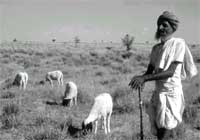Grass is greener
 MOST deserts of the world are extensive grasslands with scattered shrubs but they sustain relatively a low density of trees. Due to harsh climatic conditions, scanty natural resources and scarcity of drinking water, the deserts are thinly populated by humans. However, a wide variety of wild animals, well adapted to survive in the inhospitable environment, inhabit them due to the fair abundance of fodder, grass and top feed.
MOST deserts of the world are extensive grasslands with scattered shrubs but they sustain relatively a low density of trees. Due to harsh climatic conditions, scanty natural resources and scarcity of drinking water, the deserts are thinly populated by humans. However, a wide variety of wild animals, well adapted to survive in the inhospitable environment, inhabit them due to the fair abundance of fodder, grass and top feed.
Till the beginning of the 20th century, the Thar or the Great Indian Desert was quite similar to other arid zones mostly situated along the tropic of cancer in the northern hemisphere. Soon after India's independence, the desert scenario started changing mainly due to the escalation of human population. Starting with a population base of roughly 3.56 millions in 1901, it registered a sharp rise and increased to 16.1 million in 1991, almost a five-fold increase. In the arid districts of Rajasthan, in comparison, only four to five persons inhabit one sq km in other deserts, whereas the Thar desert houses 84 people per sq km. Moreover, the livestock population has also increased from 10.3 million during the last 30 years resulting increased severe over-grazing, a major pressure on the arid land.
Due to population pressure, the magnitude of rain-fed agriculture has also enhanced, especially, on marginal and sub-marginal lands which are unsuitable for cropping. Even the slopes of sand dunes are cultivated. There has been an increase of about 60 per cent land under the plough. Although the cropping area has increased considerably, the yield of almost all rain-fed ( kharif ) crops has drastically declined per hectare, mainly due to the loss of soil fertility and erratic rainfall.
Kharif crops like millet, sorghum, sesame and moong are usually sown soon after the first shower which may fall by the end of May or during June, although monsoon breaks in western Rajasthan only after the first of July. But in some years, the first showers are received during late May or in June. With this uncertainty in the arrival of the first shower, farmers plough their crop fields late in May and early June to utilise the supposedly early arrival of the rains.
In the modern times, bullock or camel-driven ploughs have been replaced by tractors. These mechanised farmtools till the soil much deeper than ordinary ploughs. May and June are the months when the wind speed in the desert is maximum. The hot, fast-moving winds carry away the ploughed top soil. A number of experiments carried out all over the desert by scientists from the Central Arid Zone Research Institute ( cazri ) in Jodhpur, Rajasthan, have revealed that if natural grass growing in the desert soil is removed, the soil gets air-borne at a much faster rate. The wind can remove soil that is up to 50 cm deep
